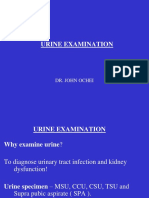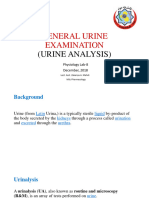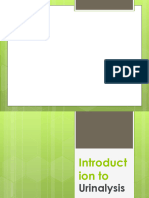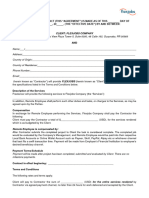Examination of The Urine Sediment: Specimen Collection
Examination of The Urine Sediment: Specimen Collection
Uploaded by
Sufariu MirelaCopyright:
Available Formats
Examination of The Urine Sediment: Specimen Collection
Examination of The Urine Sediment: Specimen Collection
Uploaded by
Sufariu MirelaOriginal Description:
Original Title
Copyright
Available Formats
Share this document
Did you find this document useful?
Is this content inappropriate?
Copyright:
Available Formats
Examination of The Urine Sediment: Specimen Collection
Examination of The Urine Sediment: Specimen Collection
Uploaded by
Sufariu MirelaCopyright:
Available Formats
23
Examination of the Urine Sediment
Heather L. Wamsley
SPECIMEN COLLECTION usually produces a sample with the best morphology for cytological
Urinalysis results are influenced by the biological variability of patients, examination. However, seeding carcinoma cells in the abdominal wall
the urine collection method, the timing of urine collection, the admin- is an uncommon, but grave, complication of cystotomy and percuta-
istration of therapeutic or diagnostic agents before collection, and neous FNB.4
the method of handling the sample before analysis.1 Ideally, at least 6
milliliters (mL) of urine should be collected before the administration
SPECIMEN HANDLING BEFORE URINALYSIS
of therapeutic or diagnostic agents to establish baseline information;
however, in patients with cystitis and urge incontinence, this may be With proper sample handling and testing, complete urinalysis may
challenging. In urinalysis, 5 mL of urine may be used; 1 mL may be rapidly provide information about the genitourinary tract and screen
used for urine culture, if necessary. When choosing the urine collec- for diseases of other body systems (e.g., endocrine, hepatic). Urine
tion method and the timing of urine collection, it is useful to consider should be collected into a sterile, single-use vessel to avoid potential
the patient’s clinical status, the logistics of the collection method, and contamination by cleanser residues and microorganisms. The body of
the intended use of the sample (Tables 23.1 and 23.2). the container, not just the lid, should be labeled, and the container
First-morning, preprandial urine samples, which are inherently should be sealed to avoid leakage of the sample and evaporation of vol-
collected after a period of nil per os (NPO, nothing by mouth), will atile compounds (e.g., ketones). Urine specimen cups often leak during
have the highest urine specific gravity and the highest concentration of transport. If urine will be sent to a reference laboratory, it should be
sediment; however, the cytomorphology of the sediment contents and transferred to a labeled, plain, white-top tube. To minimize postcollec-
the viability of fastidious microorganisms may be reduced because of tion artifacts and to obtain results that are most representative of urine
the relatively prolonged retention of urine within the bladder. If sedi- in vivo, urine samples should be evaluated within 30 minutes of col-
ment examination and urine culture are primary goals, cystocentesis of lection.5 If urinalysis will be delayed, the sample should be refrigerated
a randomly timed urine sample may be preferred in patients without and protected from light to prevent overgrowth of microorganisms
contraindications for cystocentesis (e.g., thrombocytopenia, urethral and photodegradation of bilirubin, respectively. If necessary, sam-
obstruction). Cystocentesis samples are also useful to localize urinaly- ples may be stored for approximately 12 to 24 hours (i.e., overnight).
sis findings (e.g., sediment abnormalities, proteinuria) to the bladder However, depending on the initial sample composition (e.g., pH and
or proximal urinary tract because samples obtained via cystocentesis concentration of crystallogenic substances), the sediment content may
will lack contributions from the lower genitourinary tract. be modified from what was initially present immediately ex vivo—
Samples collected during midstream micturition or by transure- crystals may form with refrigerated storage (i.e., struvite, calcium oxa-
thral catheterization are also suitable for sediment examination and late dihydrate), renal tubular casts may degrade, and cytomorphology
quantitative urine culture, which should be interpreted by using may be detrimentally altered.6 Freezing or routine use of chemical
guidelines based on collection method and colony-forming units per preservatives should be avoided. Refrigeration is preferred for preser-
milliliter (CFU/mL) (Table 23.3). Manual compression of the bladder vation of urine samples. Because cold urine may influence urinalysis
to induce micturition should be avoided because doing so may cause results (e.g., falsely increase specific gravity, inhibit enzymatic urine
reflux of potentially infectious urine, traumatic hematuria, or, rarely, dipstick reactions, and promote crystal formation), a sample that has
uroabdomen. Voided urine samples rescued from the examination been refrigerated should be permitted to warm to room temperature
room tabletop have limited utility; but, if the sediment is examined before urinalysis. If crystalluria is a medically important problem that
without delay, some components can still be assessed, specifically cells is being diagnosed or monitored, then the finding should be confirmed
that might come from the patient (e.g., leukocytes, erythrocytes, atypi- in a freshly obtained sample collected into a single-use container and
cal cells). Such a sample should not be used for biochemical analysis or analyzed within 30 to 60 minutes without interim refrigeration.5,6
to screen for infectious organisms.
In addition to routine urine sediment evaluation, urine samples
PREPARATION OF URINE SEDIMENT WET MOUNT
may be converted to a dry-mount cytology sample2,3; this allows for
more sensitive detection of bacteria and more accurate assessment of Evaluation of the urine sediment for the presence of increased
bacterial morphology and greatly facilitates evaluation of atypical cells concentrations of cells, casts, microorganisms, or crystals is use-
in-house or by a reference laboratory. The method is described in Box ful for the detection of underlying urinary tract disease or diseases
23.1. If available, cytocentrifugation of the urine sediment is equally of other organs. Gross clarity of the urine sample should not be
useful. When possible, obtaining cells directly from a mass (i.e., ultra- used as the sole means to determine potentially normal sediment
sound-guided fine-needle biopsy [FNB] or surgical biopsy imprint) findings because even nonturbid samples may be abnormal on
379
You might also like
- Municipality of Guiguinto Comprehensive Develeopment Plan CDP 2022 2027Document95 pagesMunicipality of Guiguinto Comprehensive Develeopment Plan CDP 2022 2027MILDRED LLARENASNo ratings yet
- Cylinder Block: SpecificationsDocument4 pagesCylinder Block: SpecificationsBeniamin Kowoll100% (1)
- News Bulletin ScriptDocument6 pagesNews Bulletin Scriptanahita kaushikNo ratings yet
- 1856-Cian - The Role of Cytology in Urinalysis of Dogs and CaDocument4 pages1856-Cian - The Role of Cytology in Urinalysis of Dogs and CaYaiza Garcia CasadoNo ratings yet
- Module 2 UrineDocument17 pagesModule 2 UrineGiulia Nădășan-CozmaNo ratings yet
- Urine Specimen Types and CollectionDocument7 pagesUrine Specimen Types and CollectionRyan KadavilNo ratings yet
- Urinalysis Interpretation and Clinical CorrelationsDocument21 pagesUrinalysis Interpretation and Clinical CorrelationsFercho MedNo ratings yet
- Urine CytologyDocument15 pagesUrine CytologyNaruto ShikamaruNo ratings yet
- Cap4. Urinalisis HarrrisonDocument14 pagesCap4. Urinalisis HarrrisonDiego CaceresNo ratings yet
- Complete Urinalysis and Urine Test-2Document34 pagesComplete Urinalysis and Urine Test-2azuraNo ratings yet
- Urinalysis and Body Fluid CollectionsDocument48 pagesUrinalysis and Body Fluid CollectionsladydianamacNo ratings yet
- UrinalysisDocument15 pagesUrinalysisarchivos primeroNo ratings yet
- Cabahit, Kristene Diane A. Bsmls 3-A SEPT. 28, 2020: Macroscopic Screening Also Referred To As Chemical SeivingDocument14 pagesCabahit, Kristene Diane A. Bsmls 3-A SEPT. 28, 2020: Macroscopic Screening Also Referred To As Chemical SeivingKD CabahitNo ratings yet
- Clinical Microscopy Technical ManualDocument10 pagesClinical Microscopy Technical ManualSharon ChuaNo ratings yet
- Urinalysis Dipstick InterpretationDocument14 pagesUrinalysis Dipstick InterpretationGamaliel VentoNo ratings yet
- 5 Peritoneal WashingsDocument16 pages5 Peritoneal WashingsnanxtoyahNo ratings yet
- Cytology PresentationDocument56 pagesCytology PresentationAyesha BatoolNo ratings yet
- Urine Specimens An Overview Part 1Document3 pagesUrine Specimens An Overview Part 1sulaiman zubairNo ratings yet
- UrianalisisDocument17 pagesUrianalisisPAOLA ANDREA TAPIAS PUINNo ratings yet
- Urine Specimens An Overview Part 2Document2 pagesUrine Specimens An Overview Part 2sulaiman zubairNo ratings yet
- Urinalysis (Practical) Booklet Phase 1 202223 PDFDocument17 pagesUrinalysis (Practical) Booklet Phase 1 202223 PDFmeewhayNo ratings yet
- Lesson 21 PDFDocument4 pagesLesson 21 PDFShirmayne TangNo ratings yet
- 2019-Urinary Tract CytologyDocument14 pages2019-Urinary Tract CytologyLucas Da SilvaNo ratings yet
- Aubf - 2Document7 pagesAubf - 2gianaday0816No ratings yet
- Nonblood Specimens and TestsDocument31 pagesNonblood Specimens and TestsAizeen MiguelNo ratings yet
- Rashi - Effusion CytDocument56 pagesRashi - Effusion CytShruthi N.RNo ratings yet
- Pmls2-Module 10Document5 pagesPmls2-Module 10Cherold RoldanNo ratings yet
- Topic 5. LABORATORY DIAGNOSIS OF URINE IN VARIOUS PATHOLOGIESDocument31 pagesTopic 5. LABORATORY DIAGNOSIS OF URINE IN VARIOUS PATHOLOGIESspeciald43No ratings yet
- Module 6 ReviewerDocument13 pagesModule 6 ReviewerAnne Gabrielle EspadaNo ratings yet
- Clinical Nephrology Dialysis and TransplantationDocument1,539 pagesClinical Nephrology Dialysis and Transplantationalrafeek1050100% (1)
- Urinalysisincompanionanimals Part 1Document6 pagesUrinalysisincompanionanimals Part 1Cabinet VeterinarNo ratings yet
- Lesson 9 Non Blood SamplesDocument35 pagesLesson 9 Non Blood SamplesAllen ChristianNo ratings yet
- Common Laboratory Diagnostic TestsDocument29 pagesCommon Laboratory Diagnostic Testsleyard111No ratings yet
- Urinalysis - StatPearls - NCBI BookshelfDocument1 pageUrinalysis - StatPearls - NCBI BookshelfMARVIN FERNANDO PEREZ GALINDONo ratings yet
- Urinary Sediment ExaminationDocument35 pagesUrinary Sediment ExaminationRicardo.QNo ratings yet
- Lecture 2.urine AnalysisDocument48 pagesLecture 2.urine AnalysisKarozh Jalal DuskiNo ratings yet
- Medical Pathology Ii. Pathology of Urinary System Lectuer NotesDocument26 pagesMedical Pathology Ii. Pathology of Urinary System Lectuer Noteseric epahNo ratings yet
- Urine AnalysisDocument22 pagesUrine Analysissvrlax60% (5)
- Urine ExaminationDocument36 pagesUrine ExaminationPrahlad singh100% (3)
- Lab 4.2Document5 pagesLab 4.2hussa11mvi9No ratings yet
- Macroscopic Urinalysis, Performed Manually Using Bayer MultistixDocument12 pagesMacroscopic Urinalysis, Performed Manually Using Bayer MultistixKevin TranNo ratings yet
- Lesson 10: Preparation and Handling Non-Blood Specimens in The Laboratory For TestingDocument12 pagesLesson 10: Preparation and Handling Non-Blood Specimens in The Laboratory For Testingnwgcyrb8v9No ratings yet
- Chase-Urine Sediment Examination- Potential Impact of Red and White Blood Cell Counts Using Different Sediment Methods--2018-Veterinary Clinical Pathology - American Society for Veterinary Clinical PathologyDocument9 pagesChase-Urine Sediment Examination- Potential Impact of Red and White Blood Cell Counts Using Different Sediment Methods--2018-Veterinary Clinical Pathology - American Society for Veterinary Clinical PathologyEleonora GoriNo ratings yet
- General Urine ExaminationDocument25 pagesGeneral Urine Examinationmazinhasb95No ratings yet
- General Urine ExaminationDocument25 pagesGeneral Urine Examinationpaul okelloNo ratings yet
- URINE SAMPLING METHOD - The Ideal Voided Urine Sample For Evaluation of UTI Is OneDocument1 pageURINE SAMPLING METHOD - The Ideal Voided Urine Sample For Evaluation of UTI Is OneprabhatNo ratings yet
- SOP For UrinalysisDocument8 pagesSOP For UrinalysisDennis KataraihyaNo ratings yet
- Urine Cytology: Christine BadilloDocument21 pagesUrine Cytology: Christine BadilloChristine BadilloNo ratings yet
- Exfoliativecytology 130529075655 Phpapp02Document61 pagesExfoliativecytology 130529075655 Phpapp02Electo AzevedoNo ratings yet
- Prac Urinalysis PKK3003Document18 pagesPrac Urinalysis PKK3003official smaknaNo ratings yet
- TeachingDocument18 pagesTeachingDeep PatelNo ratings yet
- Introduction To Clinical ChemistryDocument15 pagesIntroduction To Clinical ChemistryFaustina OsujiNo ratings yet
- UrinalysisDocument14 pagesUrinalysisDhine Dhine ArguellesNo ratings yet
- Stanley SlideDocument12 pagesStanley Slidesaviourmicheal2002No ratings yet
- Urine ExaminationDocument146 pagesUrine ExaminationinfodelassNo ratings yet
- Lesson-21 Exfoliative Cytology PDFDocument4 pagesLesson-21 Exfoliative Cytology PDFSasa AbassNo ratings yet
- Chapter 6 WordDocument13 pagesChapter 6 WordXyrelle SantiagoNo ratings yet
- 1 - Sed. UriDocument9 pages1 - Sed. UriRicardo.QNo ratings yet
- RENAL SYSTEM Handouts For IloiloDocument19 pagesRENAL SYSTEM Handouts For IloiloPrecious UncianoNo ratings yet
- Hematuria, (Blood in Urine) A Simple Guide to The Condition, Related Diseases And Use in Diagnosis of DiseasesFrom EverandHematuria, (Blood in Urine) A Simple Guide to The Condition, Related Diseases And Use in Diagnosis of DiseasesRating: 5 out of 5 stars5/5 (2)
- Bile Reflux: Navigating the Complexities of Diagnosis, Treatment, and Long-Term WellnessFrom EverandBile Reflux: Navigating the Complexities of Diagnosis, Treatment, and Long-Term WellnessNo ratings yet
- Urinary Stones: Medical and Surgical ManagementFrom EverandUrinary Stones: Medical and Surgical ManagementMichael GrassoNo ratings yet
- Bachat Lamp Yojna by EMCDocument8 pagesBachat Lamp Yojna by EMCmahesh_manomanjNo ratings yet
- The Freshman: Buffy Angel ShowDocument42 pagesThe Freshman: Buffy Angel ShowSupremeMugwumpNo ratings yet
- Barr StadiaDocument35 pagesBarr StadiaSwerveEFCNo ratings yet
- The Prosthetic Management of Gingival AestheticsDocument7 pagesThe Prosthetic Management of Gingival AestheticsdentureNo ratings yet
- Cadbury and Nestle: Economic Analysis ofDocument35 pagesCadbury and Nestle: Economic Analysis ofshrey narulaNo ratings yet
- Animal Tissues - Micro Notes by Seep PahujaDocument3 pagesAnimal Tissues - Micro Notes by Seep PahujaKazi AkibNo ratings yet
- 271 Mensuration Notes OH1Document32 pages271 Mensuration Notes OH1Joyjoy C LbanezNo ratings yet
- Refinery OverviewDocument79 pagesRefinery Overviewchikukotwal100% (2)
- Resume Dipta RoyDocument3 pagesResume Dipta RoyRoy DiptoNo ratings yet
- Dan-Resume-Aug-2021 1Document1 pageDan-Resume-Aug-2021 1api-337913388No ratings yet
- Difficulties in Learning Mathematics 1 The Problem and Its Background Introduction (TIOC)Document13 pagesDifficulties in Learning Mathematics 1 The Problem and Its Background Introduction (TIOC)Aldrin Balquedra-Cruz PabilonaNo ratings yet
- Impact of Perceived Social Support On Psychological Wellbeing in Young AdultsDocument7 pagesImpact of Perceived Social Support On Psychological Wellbeing in Young AdultsIJRASETPublicationsNo ratings yet
- Internal Communication HandBookDocument19 pagesInternal Communication HandBookAIESECPereiraNo ratings yet
- Flexjobs Freelance ContractDocument2 pagesFlexjobs Freelance ContractPetrea RaduNo ratings yet
- 2014 Black Rhino EAZA Best Practice Guidelines ApprovedDocument85 pages2014 Black Rhino EAZA Best Practice Guidelines ApprovedGergely Sandor NagyNo ratings yet
- Basic Physical Examination in ENT PDFDocument44 pagesBasic Physical Examination in ENT PDFJayricDepalobosNo ratings yet
- Ecm - Engine Control System (Mr20dd)Document416 pagesEcm - Engine Control System (Mr20dd)Eliecer Bayona100% (4)
- Understanding ISO Codes Appearance of Water in Oil: Viscosity Grading SystemsDocument1 pageUnderstanding ISO Codes Appearance of Water in Oil: Viscosity Grading SystemsPorfirioDuarteZarateNo ratings yet
- Support Vector Machine (SVM) PDFDocument15 pagesSupport Vector Machine (SVM) PDFDhivya S - 67No ratings yet
- Shear-Strength DataDocument19 pagesShear-Strength Datacheveresan123No ratings yet
- Design of DomesDocument7 pagesDesign of DomesGandhi HammoudNo ratings yet
- Character-Integrated Lesson PlanDocument1 pageCharacter-Integrated Lesson PlanChristopher Martin GunsatNo ratings yet
- Expansion of SUBWAY in China: Research ReportDocument26 pagesExpansion of SUBWAY in China: Research ReportHafizah Aziz100% (1)
- 2010 Freedom Conference ProgramDocument16 pages2010 Freedom Conference ProgramSteamboat InstituteNo ratings yet
- EFPS - eGOV Corporate Enrollment (CMS-060 (12-21) TMP)Document2 pagesEFPS - eGOV Corporate Enrollment (CMS-060 (12-21) TMP)alyssamarie.shoumuraNo ratings yet
- 7061581-STR-DWG-KRP-3090 (Sheet 1 of 3)Document1 page7061581-STR-DWG-KRP-3090 (Sheet 1 of 3)Sibtain AliNo ratings yet
- Civil Hydraulics Lab ReportDocument24 pagesCivil Hydraulics Lab ReportKevin OnyangoNo ratings yet

























































































